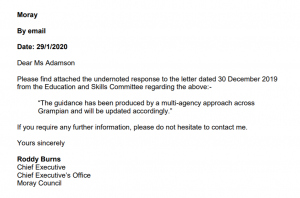With reference to our Petition PE01692, the Education & Skills Committee wrote to local authorities in December 2019 regarding revised guidance on data processing, which the Information Commissioner’s Office published in 2016 after previous advice from 2013 had to be withdrawn in the wake of the Supreme Court’s ‘named person’ judgment.
Having requested, and received on 30 November 2020, copies of council submissions from the committee clerk, we have completed an exercise in comparing their responses (from January and February 2020) with information on GIRFEC data collection / sharing sent to parents or published on their websites (as of December 2020).
Also of relevance to this investigation is our article GIRFEC Named Person data collection and sharing: examples of unlawful guidance in which we highlighted problematic policies, including the 2014 national child protection guidance (now being updated) that still links directly to flawed ICO ‘advice’ from 2013 and cites an unlawful threshold for non-consensual data processing.
Under present Data Protection law it is perfectly acceptable and lawful for services to share information, where there is an indication that a child’s wellbeing is at risk. [Unlawful in the absence of consent below the significant harm threshold as the vague notion of ‘wellbeing’ fails to meet the legal tests] Under such circumstances, consent is not required and should not be sought as the holder of the information can rely on alternative and more appropriate conditions from schedules 2 and 3 of the Data Protection Act 1998. This has been reaffirmed through the publication of advice by the Information Commissioner [who was completely wrong in this regard and was obliged to withdraw the statement following the 2016 named person ruling and a lawyer’s letter].
We invite parents to assist our ongoing investigations by sending us relevant links and/or copies of council communications. These can be posted on our members’ group, sent via our public Facebook page or our website contact form.
Aberdeen City | Aberdeenshire | Angus | Argyll & Bute | Clackmannanshire | Comhairle nan Eilean Siar | Dumfries & Galloway | Dundee | East Ayrshire | East Dunbartonshire | East Lothian | East Renfrewshire | Edinburgh | Fife | Glasgow | Highland | Inverclyde | Midlothian | Moray | North Ayrshire | North Lanarkshire | Orkney Islands | Perth & Kinross | Renfrewshire | Scottish Borders | Shetland Islands | South Ayrshire | South Lanarkshire | Stirling | West Dunbartonshire | West Lothian
ABERDEEN CITY
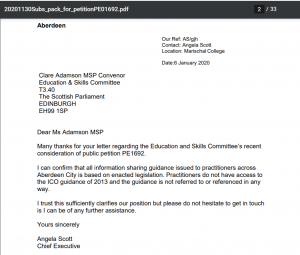
Council website (accessed 1 December 2020)
Info Sharing Practitioners Guidance (March 2019)
Still about wellbeing. Excerpts of interest (our comment in red):
SHARING INFORMATION TO SUPPORT AND PROTECT CHILDREN AND YOUNG PEOPLE
If you are concerned about an unborn baby, child, or young person’s wellbeing, and believe they require support; you should consider the 5 GIRFEC Questions(in accordance with the National Practice Model):
1.What is getting in the way of this child or young person’s wellbeing?
2.Do I have all the information I need to help this child or young person?
3.What can I do now to help this child or young person?
4.What can my agency do to help this child or young person?
5.What additional help, if any, may be needed from others?A concern can relate to a single issue or incident, or may arise from a series or pattern of events. The 5 GIRFEC Questions help you consider whether there is a need to share information in order to develop a more robust assessment and/or plan of intervention to support a child or young person.
Why share information?
A child or young person’s wellbeing is of central importance, when making decisions to share information with or about them. Wellbeing is a continuum which ranges from early intervention and prevention, right through to child protection.* The reason why information may need to be shared or processed, or particular action taken, should be discussed openly and honestly with children, and where appropriate their families, ensuring their views are sought and recorded….
Legal Justification for sharing wellbeing concerns
When considering whether to share information, you should refer to your agency’s specific statutory/legal functions, as these relate to supporting, promoting, or protecting children’s wellbeing.** This will provide you with a clear legal basis which empowers you to share information where this is necessary to deliver statutory professional duties, or is in the public interest…
* There is a threshold for intervention – risk of significant harm, which should never be conflated with ‘wellbeing’.
** Both statutory duties and public functions/tasks are limited by Article 8 (as interpreted by the UK Supreme Court) in order to prevent arbitrary interference.
Confidentiality is not an absolute right
It is important to be aware of the limitations and constraints of confidentiality -there is no absolute duty of confidentiality, and this should always be clearly explained to those who are accessing services.
Sharing of information should always be necessary, proportionate, relevant, and lawful. This means that you should share no further than the minimum necessary to achieve the objective of protecting a child or young person’s wellbeing,* and that you must ensure any information you share is done so in accordance with the principles of the Data Protection Act 2018,GDPR,and any other relevant legislation.**
* ‘Wellbeing’ is not the legal threshold.
** Including Article 8 of the ECHR
When should I ask for consent?
The need for explicit consent should be considered before any information has been shared. Consent should only be sought when the individual has a genuine choice over how their information/data will be used, and there is a difference between having a discussion where you advise and explain to an individual that you intend to share their information, and asking for their consent to do so.
If we are to get it right for every child and young person, we need to intervene early to support their wellbeing.* To achieve this we need to work in a way which changes the emphasis from crisis management to early identification, intervention and support. Often this will involve proportionate sharing of personal information, and in some cases very sensitive personal information.
* Intervention is only ‘necessary’ when the legal threshold has been met and it is not ‘state defined wellbeing’; otherwise, informed consent is the lawful basis.
Appendix B
…….Adopt a common sense approach: use your professional judgment, knowledge and skills, and listen to your gut feelings….
Confidentiality does not prevent you from sharing a worry or concern about a child or young person’s wellbeing -it actually empowers you to do so.*
* This is a reference to ICO ‘advice’ from 2013 that had to be withdrawn in 2016.
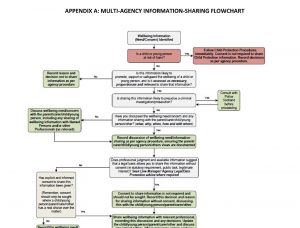
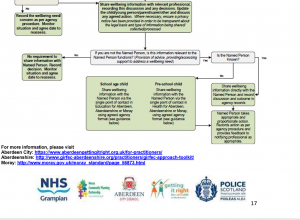
ABERDEENSHIRE
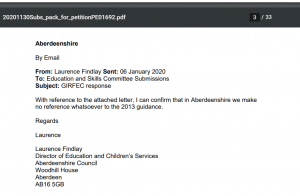
Council website (links all accessed 2 December 2020)
March 2019 version. Identical ‘guide’ to Aberdeen City’s, which cites ‘perceived risk to wellbeing’ straight from the ICO’s original ‘advice’ and citing the Data Protection Act 1998 (now superseded).
“In order to ensure consistent practice, partner agencies across Aberdeen City Council, Aberdeenshire Council, Moray Council, Police Scotland and NHS Grampian have produced this information sharing guidance for all practitioners and managers working with children, young people and their families within the public, private and third sectors.”
PROTECTING CHILDREN AND YOUNG PEOPLE IN EDUCATION Book 1 The Context
Excerpts of interest:
10. Information sharing and child protection
Under present Data Protection law it is perfectly acceptable and lawful for services to share information where there is an indication that a child’s wellbeing is at risk. [wrong threshold] Under such circumstances consent is not required and should not be sought as the holder of the information can rely on alternative and more appropriate conditions from schedules 2 and 3 of the Data Protection Act 1998. [outdated data protection legislation] This has been reaffirmed through the publication of advice by the Information Commissioner. [advice withdrawn in 2016]
However, the correct threshold is cited by GIRFEC Aberdeenshire:
If a Named Person, or anyone else, has concerns for a child’s safety, or thinks a child may be at risk of abuse, neglect or significant harm, that person would be expected to share information about a child or family member. Decisions to share information are based on professional judgments and available information, and this will only take place in circumstances where it is proportionate, legitimate and necessary to do so.
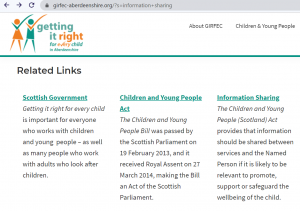
ANGUS
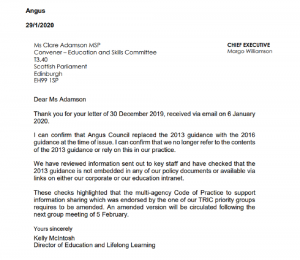
Council website (accessed 2 December 2020)
Getting it right for every child page refers to services working together to support children and young people, but information is minimal and signposts to the Scottish Government website.
A deep dive uncovered an Agenda Item from the CHILDREN AND LEARNING COMMITTEE – 20TH SEPTEMBER 2016 on the NAMED PERSON SERVICE in the wake of the Supreme Court ruling.
2.7 Current information sharing arrangements in Angus are designed so that they meet the conditions as set out in the Data Protection Act, namely that “when information needs to be shared, that children and families know why this information should be shared, and that consent has been given and recorded, unless, in exceptional circumstances, there is good reason not to.” Information is only shared with the consent of parents or carers or where there are significant concerns for the safety or wellbeing of an individual child.
ARGYLL & BUTE
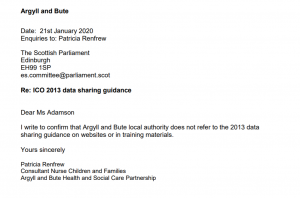
Council website accessed 2 December 2020)
Bizarrely, the only data sharing link found was from 2008:
Data Sharing Partnership Document 2008
Our researcher reports that the Argyll & Bute Girfec page dated November 2020 refers practitioners to the above Highland Data Sharing Partnership 2008, which has not been updated to include any of the new legislation. No mention of the 2013 ICO guidance, the 2016 update or other relevant legislation / guidance / case law since then.
Excerpts of interest (from 2008 but linked from a new 2020 website):
“Where consent has not been given, but there is a need-to-know, legislation assists the practitioner to decide whether sharing should take place. Legislation supports the commonsense approach to making this decision –if data is to be shared to prevent harm, to prevent or detect crime or to improve the wellbeing of individuals or groups or for public protection and if the information to be shared is relevant and proportionate, then data should be shared.”
“If the data to be shared comes within the scope of the DPA, the reasons for sharing must meet at least one of the conditions defined in Schedule 2 of the DPA [superseded, of course, by the DPA 2018]
It will be seen that these are very broad conditions. Most of the data shared within the agencies of the Highland Data Sharing Partnership will be covered by conditions 1, 3, 4, 5a, 5d or 6. If the data to be shared is personal data, and the reasons for sharing satisfy at least one of the above conditions, the data may be shared.
If the data to be shared is sensitive personal data, and the reasons for sharing satisfy at least one of the conditions from Schedule 2 AND at least one of the conditions from Schedule 3, the data may be shared.”
Note no consent required.
It goes on:
“The Human Rights Act 1998
Article 8 of the Convention is of particular relevance to data sharing.
The HRA does not pre-empt the requirements of other areas of law (although there is some overlap). For example, the requirements of the DPA must also be satisfied. However,, in most cases if the conditions described in Schedules 2 and 3 of the DPA are met when data is shared, the requirements of the HRA will also be met.”
Obviously no reference to most recent case law that settled the threshold for interference with Article 8 but still linked to from a new 2020 website.
Comment by our researcher:
The document does have a section on consent and talks of informed and explicit consent saying “Implied consent is not sufficient for data sharing” and talks of the “welfare” of a child being “the paramount consideration.”
There is a document on the list for Practitioners called ‘20180611 Public Protection Information Sharing’, which appears to be dated 2018, but it returns an error message.
We needed to do some deep diving to locate this document, dated September 2016, presumably following the ICO’s updated statement, which we had previously linked to:
Except where a child may be at risk of harm or abuse, information sharing must be proportionate and with informed consent. The Named person should only pass
information to other services with consent, and should only receive information from other agencies with consent. If you are in any doubt about sharing information have a discussion with your line manager and record the decision.
Much better, but no link from the main GIRFEC page. Why not?
CLACKMANNANSHIRE
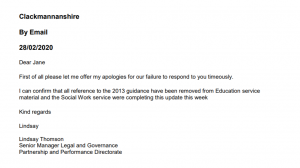
Council website (accessed 2 December 2020)
Getting It Right For Every Child
Wellbeing is now part of legislation under the Children and Young People (Scotland) 2014 Act. Our health and education services routinely engage in assessing the wellbeing of all children and young people using the 8 wellbeing indicators noted in the Act… [the word for this is ‘profiling’ in order to enforce state outcomes / ideology; it also constitutes data processing without consent and does not meet the ‘necessity’ test as affirmed by the Supreme Court]
Key elements of the GIRFEC approach have been introduced into law under the Children and Young People (Scotland) 2014 Act:
Wellbeing is described [but not defined to satisfy precision, foreseeability and accessibility tests, and said by the Supreme Court to be ‘vague’] in legislation for the first time to help make sure everyone uses the same [subjectively interpreted] terminology and [non-negotiable / imposed] approach.
Children and young people will have access to a local Named Person Service – a single point of contact for help, support and advice for children, young people and families and those professionals working with children if they need it.* The Named Person Service will be available through the Universal Services of Health and Education. The uptake of the Service is on an entirely voluntary basis, unless there are compulsory measures in place and/or child protection concerns.
* Parts 4 & 5 of the 2014 Act never came into force and are to be repealed. No mention of information gathering/sharing that may precede the ‘uptake’ offer of a ‘voluntary’ service with fully informed GDPR-compliant consent.
The Children and Young People Act introduces a description of how people working with children, young people and parents understand and consider a child or young person’s wellbeing.
Wellbeing is broader than child protection and how we tend to think about welfare. [and is not the threshold for intervention, inc data processing without consent]
COMHAIRLE NAN EILEAN SIAR
Response to the Convener of the Education & Skills Committee
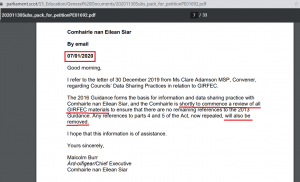
Council website (accessed 30 November 2020)
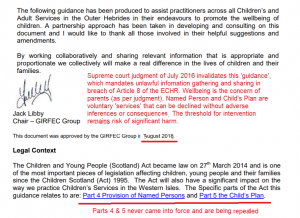
Multi Agency Guidance: The Single Planning Process Supporting the Single Child’s Plan
Archived link
Main Responsibility: All Named Persons and Lead Professionals
Relevant Legislation: Children and Young People (Scotland) Act 2014*
* Parts 4 & 5 never came into force and are being repealed
Excerpts of interest (our bold):
If wellbeing concerns are received by practitioners who are not Named Persons or Lead Professionals then they have a duty to share that wellbeing concern with the Named Person or Lead Professional *
As stated above it is incumbent upon practitioners if they are not the Named Person to share information relating to a wellbeing concern. This does not mean that every piece of information held about a child/young person and their family has to be passed on to the Named Person but that proportionate information in relation to the wellbeing concern does have to be passed on.
It is good practice to discuss with a child/young person and their family information relating to the wellbeing concern(s) that will be passed on to a Named Person or Lead Professional but it is not necessary to seek the family’s agreement before passing that information on.**
* This unlawful ‘duty’ never came into force and Parts 4 & 5 of the 2014 Act are to be repealed.
** It is necessary unless the legal threshold (whcih is not ‘wellbeing’ but risk of significant harm) is met.
DUNDEE
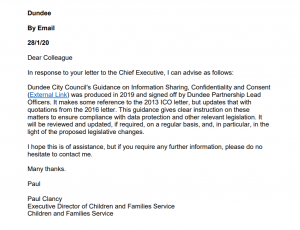
Inter-Agency Child Protection Operational Instructions – Dundee Child Protection Committee
“The Instructions should act as a practical reference point for professionals who are working with children and/or their families and have concerns for their safety or wellbeing. They should not be regarded exhaustive and they do not replace specific single agency procedures, for example those used in Health Service and by Police. The instructions add to them.
Whilst these Instructions do not constitute legal advice, they do aim to provide clear and unambiguous processes to all staff to enable them to safeguard, support and promote the wellbeing of all children and to protect them from harm and abuse.
Legislation places a variety of duties and responsibilities on services and organisations. These include duties conferred on services to investigate and respond to concerns about a child’s wellbeing, as well as the responsibilities of local authorities to develop community planning processes with partner agencies.
The main purpose of policing is to improve the safety and wellbeing of persons, localities and communities in Scotland … [which does not extend to interfering with Article 8 of the ECHR which serves to limit domestic legislation, as clarified by a leading lawyer].
Part 3 of the Act (Local Government in Scotland Act 2003) deals with the power of local authorities to enhance wellbeing and again this can be interpreted as being relevant to the establishment of Child Protection Committees. [but does not extend to enforcing wellbeing outcomes / state ideology by collecting/sharing data and profiling children and families]
When professionals are concerned for the wellbeing or safety of a child, they must act [only for the latter when the threshold is met or very likely to be met]. They should in the first instance share their observations and concerns with their own manager or designated child protection officer and decide what the next steps should be. It needs to be borne in mind at this point, that it will be unlikely that they have all relevant information relating to the child, and it will almost certainly be necessary to talk to other agencies’ who know the child or their family. [not on the basis of subjectively ticked ‘wellbeing’ boxes].
5.2 Child Protection Plans
In line with GIRFEC (Getting It Right for Every Child) Wellbeing Indicators, each child, where professionals have raised a concern, must have a Child’s Plan and this will be agreed and monitored through Team Around the Child Meetings. [‘Welbeing’ concerns, i.e. failing to achieve state outcomes, do not meet the threshold for non-consensual intervention, including data sharing, which is risk of significant harm. Part 5 of the 2014 Act never came into force, thus rendering the GIRFEC Child’s Plan voluntary with no adverse consequences for declining as affirmed by the Supreme Court. A child protection plan is contingent on a higher threshold being met].
Appendix 2 Guidance, Research, Publications
First link titled ‘Information sharing on behalf of Judith Ainsley, Head of Child Protection, Scottish Government dated 25 May 2018 returns ‘page not found’.
Named Persons in Dundee had continued to function after the Supreme Court judgment on the basis of 2013 ICO advice, but the previous link now returns this especially cute 404 error page.
.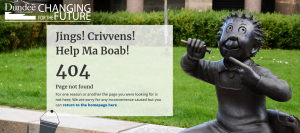
DUMFRIES & GALLOWAY
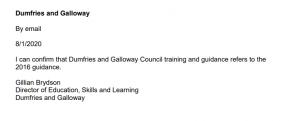
Parents have previously shared with us concerns and complaints about data processing by the council. Neither legislation nor guidance confers powers on public bodies that arbitrarily interfere with Article 8 rights, as re-affirmed by the Supreme Court and the point has already been conceded:
With regard to your concern about the implication that the Council’s decision to proceed and contact other statutory agencies, without your prior informed consent, for checks on any concerns that they may have about your children, I find that you are justified in this aspect of your complaint. In relation to this specific point of complaint about the absolute decision by the Council to withhold consent from parents to home educate their children, if the parents do not give consent to the Council for undertaking their checks with statutory agencies, I find that there is nothing in the national guidance or the relevant legislation that confers either a duty or a power to support the Council’s procedure and its decision in this respect.
Council website (accessed 6 December 2020)
Support for children and families
The GIRFEC page (updated 3 January 2020) contains links to information about the Lead professional and a video case study.
GIRFEC is a national approach to improving a child’s well-being and you can find out more from the Scottish Government website.
The Child protection page (updated 7 May 2019) refers to risk of ‘harm’.
Report a concern about a child or young person
It’s everyone’s responsibility to ensure that children are safe. If you are worried that a child or young person may be at risk of harm then you should call 030 33 33 3001 and ask for the Children’s MASH.Child protection inquiries explained
When someone contacts us with concerns about a child we start our child protection inquiry process.
The Privacy statement page contains links to service specific notices.
Privacy Notice Education and Learning Directorate
Sharing personal data to support Wellbeing If it would be helpful to share information about a child or young person with someone else, we will discuss this with you and seek your consent before we share it so that you know what is happening and why. The only time we will not seek consent to share information with another organisation is if we believe that a child may be at risk of harm. In these situations, we have a duty to protect children, which means we do not need consent. On these occasions, we will normally tell you that information is being shared, with whom, and why – unless we believe that doing so may put the child at risk of harm.
Arrangements for Named Person Service (Education) during School Holiday Period (dated July 2020)
Initial Referral Discussion (IRD) During a holiday period, education information which is required for an IRD, will be accessed by Social Work working within the Multi-Agency Safeguarding Hub (MASH) directly from SEEMIS. A note will be entered by Social Work within the Wellbeing Application, which will flag to the Named Person.
[N.B. The SEEMiS ‘Wellbeing Application’ is not specific to Dumfries & Galloway Council and we are making separate enquiries about its use across LAs, which has already raised concerns, including on profiling of pupils and the default ‘overriding of consent’ to share information.]
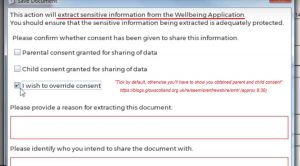
EAST AYRSHIRE
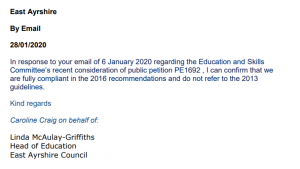
Council website (accessed 4 December 2020)
Interim Practice Note: Role of Named Person and Lead Professionals (dated October 2014, still on website)
The Named Person is responsible for ensuring core information is up to date, assess if a child is not meeting their developmental milestones including emotional or physical milestones or once started school, benefitting fully from education and determine what extra help may be required from within their agency or from other agencies if appropriate. They will contribute information to other agencies completing an assessment and contribute to planning for the child at transition points and passing on information to a new Named Person. [since this is from 2014, no mention of need for consent, following ICO ‘advice’]
Any concerns [read to include ‘wellbeing’ trivia] passed to the Named Person should be actioned appropriately. This of course does not preclude others taking action in line with child protection guidelines. This may mean:
carrying out an assessment; [data processing, lawful basis?]
adding to an existing assessment; [ditto]
including the information in the Child’s Single Agency Chronology of Significant
Events and if appropriate their Integrated Chronology of Significant Events on AYRshare.[cross-agency database that arguably breaches Article 8]
Education policies and legislation page cites the 2014 Act as if Parts 4 & 5 came into force.
Children and Young People (Scotland) Act 2014
This is perhaps the most important piece of legislation and sets out a number of key requirements as follows:Named person [never came into statutory force, to be repealed]
This sets a requirement for Health Boards to provide children with a named person from birth up to when they go to school. Local authorities must provide children in schools with a named person from school age to 18, or until they leave school, whichever is later.Lead professional
All children and young people who need support can access this from one person – called a lead professional – who will act as a single point of contact for the child, or family and co-ordinate the care required across a range of different services.Child’s plan [never came into statutory force, to be repealed]
Local authorities require to prepare a plan in relation to an individual child if it is considered that a child has a wellbeing need. This is required if it is considered that wellbeing cannot be met without targeted intervention.
They provide a handy GIRFEC multi-agency wall planner (dated 2019) but warn that guidance must be consulted. There are significant errors, no least of all misrepresentation of the voluntary nature of the named person scheme and the lack of lawful basis for (subjective) ‘wellbeing concerns’ and personal data being shared between agencies without prior consent.
The Information Sharing Flowchart and guidance should be followed when information
requires to be shared with another agency or service. Where there is a concern for a child’s
wellbeing, proportionate* sharing of information is required within the TAC. [This is incorrect and should only be done with consent or other statutory basis below the significant harm threshold. GIRFEC has no statutory force and ‘wellbeing’ has been described by the Supreme Court as a vague and subjective notion that fails to meet the tests of precision, accessibility and foreseeability]
* Proportionality is apparently ‘well understood’ by professionals. Here is one trying to explain it (who is, coincidentally, part of the ‘team’ revising the 2014 national child protection guidance that relies on, and still links to, the ICO’s 2013 ‘advice’ – see footnote 13, page 23).
EAST DUNBARTONSHIRE
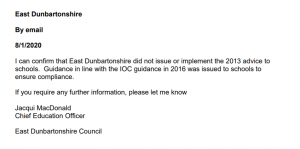
Communications to parents tell a different story
This example was clearly implementing the 2013 ICO ‘advice’ after parental SARs (for which a court order had to be obtained) revealed secret multi-agency meetings with ‘Don’t tell mum’ attached to records after consent to share data had been refused. Only one professional declined to share information based on her professional code.
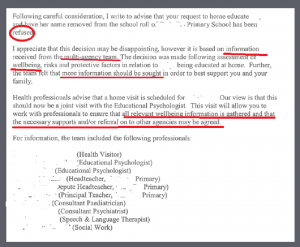
Council website (accessed 4 December 2020)
There is hardly a mention of GIRFEC, but…
Education – Pupil Support Group, TAC, Support for All [GIRFEC rights based? The 2016 Education Act limits UNCRC rights.]
Before your child (aged 12-15) makes use of their rights, the school or local authority must decide if your child’s use of their rights will negatively affect their wellbeing.
Professionals will look at several areas of wellbeing to decide whether your child’s use of their rights will negatively affect their wellbeing. They will consider whether it will affect your child being … [SHANARRI indicators compliant] The Personal Data will be shared with other departments within East Dunbartonshire Council and other organisations for purpose of providing an educational psychology service. We will only share information with other departments within the Council, such as Education and Social Work, where this is necessary to allow us to provide an educational psychology service.
If asked to share data, Educational Psychologists will use their professional judgement to identify which information is appropriate and necessary to share with the other professionals involved, in order to inform decision-making and assessment.
Other organisations may include the Scottish Children’s Reporter’s Administration under statutory duties set out in the Social Work (Scotland) Act, 1968 and Greater Glasgow and Clyde NHS under responsibilities set out in the Children and Young Peoples (Scotland) Act 2014 (GIRFEC Initiative) [does this include Parts 4 and 5 that never cane into force and are due to be repealed?] We will only share information with an outside body if you are currently or if you become involved with these services.
Education and Social Work Directorate Education Service Child Protection Policy and Procedures (Revised April 2019)
Key Reference Documents and Links:
National Guidance for Child Protection in Scotland [which cites and links to 2013 ICO ‘advice’]
National Guidance for Child Protection in Scotland 2014. Additional notes for practitioners: protecting disabled children from abuse and neglect
Getting it Right for Every Child [links to Scot Govt site]
West of Scotland Inter Agency Child Protection Procedures [returns 404 error]
EAST LOTHIAN
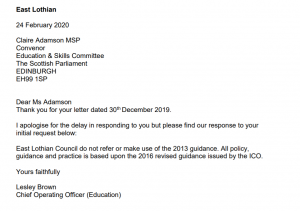
Council website (accessed 4 November 2020)
Named Person Scheme – business as usual for East Lothian (from August 2016)
After the Supreme Court judgment the Head of Education at East Lothian said they would ‘carry on sharing wellbeing concerns’ and ‘continue training staff on the Named Person application’. The Head of Children and Adult Services said the council was working closely with the Health Visiting Service ‘who are also operating on a “business as usual” basis’.
An archived link to the same page from December 2017 (after the 2013 ICO advice had been formally withdrawn) included a short mention of the 2016 updated advice below the ‘carry on regardless’ bravado from the line-up of officials.
Getting it Right for Every Child (GIRFEC)
Named Person leaflet (dated 2016) refers to the 2014 CYP Act as if Parts 4 & 5 had come into statutory force which they never did and are set to be repealed. The messages are somewhat mixed:
Information about their needs and circumstances may be shared with a Named Person if it’s relevant to understanding what help they may need and it supports their wellbeing, this will be done in discussion with the child and their parent(s), unless there is a child protection concern. They will not directly access personal information held by other services.[barely credible given the council bullish position in the 2017 archived link above]
Understanding Wellbeing leaflet (also 2016) flogs the ‘shared understanding’ and implies parents ared expected to apply state dictated indicators to their children.
Families and people working with children and young people can use the wellbeing indicators to identify what help a child or young person needs in order to help them access the right support or advice. All services working with children and young people, and those who care for them, must play their part to promote, support and safeguard children and young people’s [state dictated, not self-determined] wellbeing. It is up to all of us – parents, early learning providers, health visitors, teachers, GPs, police – to work together to promote, support and safeguard the wellbeing of all of our children and young people. [language of state imposed ‘shared’ ownership of children]
EAST RENFREWSHIRE
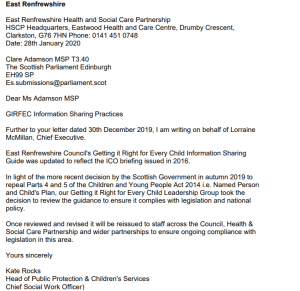
Council website (accessed 4 December 2020)
Only relevant mention of GIRFEC was found via site search on the Child Protection Committee page (updated June 2020) which links to the Scot Govt GIRFEC pages.
However, this Getting It Right For Every Child in East Renfrewshire was saved in December 2020.
Any practitioner who identifies wellbeing issues for a child or young person should also ask the 6 key questions and share this information with the Named Person in order that the child’s needs can be addressed in a coordinated way. [‘wellbeing’ is not the threshold for processing personal data without consent]
Among the Named Person’s stated responsibilities:
Seek assistance from other agencies when it is appropriate and proportionate to do so
Act as a point of contact for other agencies and respond to requests for information sharing
When sharing information with others ensure the child and family understand why this is happening and record the decision to do so. [no lawful basis apart from informed consent below the child protection threshold as GIRFEC has no statutory force and ‘wellbeing’ concerns cannot be routimely shared between services]
EDINBURGH
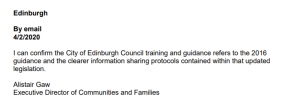
Council website (accessed 30 November 2010)
Thank you to our volunteer researcher for providing the following information.
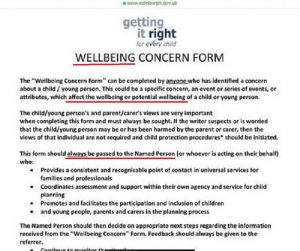
The council is gathering subjective ‘wellbeing’ data (i.e. profiling children) and sharing it with a ‘named person’ without prior consent, who decides on how to further process the ‘wellbeing concern’. This can apparently be conducted by stealth unknown to data subjects. Such data processing potentially interferes with Article 8 of the ECHR and families may object on the basis of unwanted profiling to enforce state outcomes.
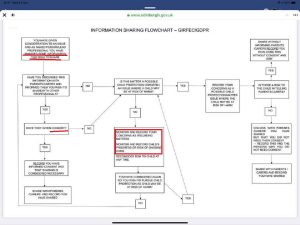
The flowchart alludes to ‘amassed’ data by a named person / lead professional with no mention of the lawful basis for recording subjectively interpreted ‘wellbeing concerns’ based on undefined ‘indicators’ and tick boxes. However, consent is stated as the basis for further processing (sharing) below the child protection threshold. ‘Processing’ is the regulated activity and that includes initial gathering through to final deletion.
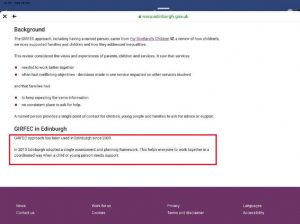
The single assessment and planning framework, said to be in place since 2013, is almost certainly based around ‘wellbeing’ as the (wrong) threshold for data processing, which all councils were encouraged to adopt following the issue of flawed ICO ‘advice’ procured by the GIRFEC board. We know from previous investigations that the Council began implementing GIRFEC and the Named Person policy across 2010 and 2011 [link now dead]. They are still running a scheme, but now with a nod to its voluntary nature.
Wellbeing of children and young people
The indicators were informed by a Scottish study that considered all aspects of life that are important for children and young people to reach their full potential. [i.e. opinion, with the presumption of agreement with an imposed interpretation and imposition of ‘wellbeing’] Having a shared understanding of wellbeing means that we can work together to achieve better outcomes for children and young people.[outcomes driven, not rights based and cannot lawfully be mandated]
Links to templates and guidance links that we have not fully scrutinised. [Part 5 – Child’s Plan – of the 2014 Act never came into force and is to be repealed; can be declined]
All children up to age 18 are entitled to a named person. Parents or children don’t have to contact their named person or accept any support offered.
In addition, this FOI request is currently awaiting a response.
FALKIRK
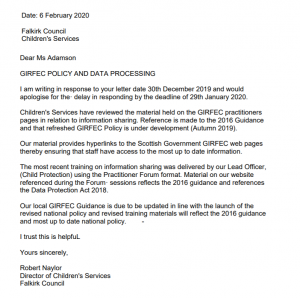
Council website (accessed 4 December 2020)
Getting it Right for Every Child (GIRFEC)
The wellbeing of all children and young people is at the heart of GIRFEC. Services must work together with children, young people and their families to provide quick and effective support when it is needed. [no mention of informed consent or right to decline ‘services’]
Every child and young person will have a Named Person to make sure their wellbeing is promoted.[ rights or outcomes, no mention of consent?] Wellbeing is described by 8 indicators (sometimes called SHANARRI) [but GIRFEC is not statutory and, as affirmed by the Supreme Court, ‘wellbeing’ has no precise legal definition]
FIFE
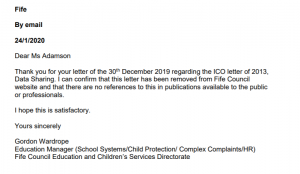
Council website (accessed 5 December 2020)
Links to the Child Wellbeing Pathway which is
“.. set firmly within the context of GIRFEC and SHANARRI to assist broader assessments relating to the needs, risks and strengths pertaining to a child. This Pathway therefore supports early identification of concerns and may, as one potential outcome, lead to child protection issues being identified. Follow this link for access to the Child Wellbeing Pathway guidance and associated documents”.
This Child Wellbeing Pathway guidance appears to be from 2018. We could not find an updated version of this document.
Section 4 (Information Sharing)
“At the time of writing [date not specified] the Scottish Government is reviewing the Information Sharing provision and guidance contained within The Children & Young People Act (2014). This document contains advice and guidance that is consistent with existing legislation and national guidance [the national child protection guidance links to 2013 ICO advice], and will be updated in due course if required to ensure that it is compliant with the new advice from the Scottish Government.”
“There are situations when practitioners may be concerned that a parent/carer is putting their own needs ahead of the child’s/young person’s. In such situations, it can be difficult to establish what, if any, level of risk the child/young person may be experiencing. Therefore it is difficult to establish whether the level of risk is significant enough to share information without informed consent. In such situations, there is an even greater need to ensure that our assessment of wellbeing is rigorous and accurate regarding the needs of the child/young person.” [no consent to process ‘wellbeing’ data and no other lawful basis]
“The Data Protection Act 1998 [which has been superseded by the 2018 Act] places an obligation on the police to ensure sufficient security to prevent accidental or unauthorised disclosure of sensitive information.”
“Information sharing regarding concerns in respect of sibling groups will support a ‘whole’ family approach to Wellbeing Assessment and decision making regarding next steps. If a Wellbeing Assessment is to be progressed then this should be done in conjunction with the other named person(s). Similarly, it would be good practice to ensure that, where relevant, all named persons are included in Child Wellbeing Meetings.”
“The expectation is that the Wellbeing assessments provided for the purpose of this meeting will be shared with all parties (including the family) along with the note of the meeting or a Child’s Plan take explicit note of the guidance above regarding Police information. The accountability for the information shared rests with the receiving service.”
This document does contain some good advice:
“A child/young person and/or their parent/carer have the right to refuse consent for practitioners to share information with another service. In such situations it is not appropriate or acceptable for a practitioner to share that information anyway unless they have assessed that there is a potential risk of significant harm if they do not do so – in such situations Child Protection processes should be followed.”
But this is confused and contaminated by the references to ‘wellbeing’.
Under Information and Advice for Practitioners: Information Sharing
“The general principles in relation to Information Sharing for child protection are:
- The safety, welfare and wellbeing of a child or young person are of central importance when making decisions to lawfully share information with or about them…
Children and their parents/carers should be made aware that agencies will share confidential information in a responsible way to ensure the safety and wellbeing of children. It should over-ride any perceived risk of damaging the relationship between a professional and their service user.
If a child’s wellbeing is or is likely to be at risk, relevant information must always be shared in a proportionate manner.”
Again, there are references to safety and welfare but the use of ‘wellbeing’ simply muddies the water over what the threshold actually is. The blame will be laid firmly at the door of practitioners who fail to get it right.
GLASGOW
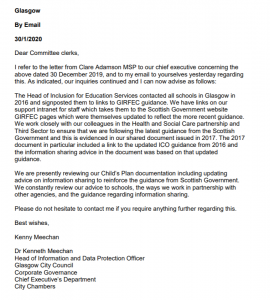
Council website (accessed 5 December 2020)
Information Sharing
- The Children and Young People (Scotland) Act 2014 enforces a duty to share information where there are concerns about a child or young person’s wellbeing with their Named Person.
- The Named Person will be fully aware of matters that may have an effect on the child or young person’s wellbeing.
Guidance on a common approach for professionals in Glasgow to assessment, planning and care management for children and young people (Version: 20 January 2017) We could not find a more recent version.
6.2 Sharing Information on WellbeingIn Glasgow, professionals across Health, Social Work and Education Services have shared information to assist a child, young person or their families.This has always been done in a respectful and proportionate way and where possible with the consent of the child, young person or parent/carer.A Named Person should build a trusting relationship with the child, or young person and their families. They should work with the family, explain what they are doing and why. The child, young person and families should be involved and have their say about any decisions made about them. As a Named Person, you should be a person who knows the child and their family well, so when it comes to discussing sharing information with another agency, the child and family will understand this is being done to assist them, not for any other reasonWhere there is a need for a multi-agency approach to the assessment and a child’s plan is required the Named Person or Lead Professional should obtain consent from the child and their family for the assessment process being initiated and discuss the need to share information across agencies.It is essential that a child’s right to privacy is considered at the heart of any decisions that are made about them. Where the child is able to consent they should be asked to do so before any information is shared about them. If the child is unable to consent then the parents should be asked to do so on his/her behalf.If the child withholds consent against parental agreement then the wishes of the child should be considered paramount, so far as this does not affect their care or endanger them in any way. If however, the child and/or the parent refuse, but there is an evidenced view that the child is in need and/or at risk, then the Lead Professional should initiate formal child protection procedures. This will lead to the assessment being completed following consideration of any immediate risks to a child.If any agency has concerns that a child is suffering significant harm or will do so in the future, Child Protection procedures must be followed.Practitioners endeavour to address all of these parts in the way most appropriate to the child or young person’s needs. Recognising this shared agenda makes it easier for practitioners from different disciplines to work collaboratively.We are awaiting Scottish Government guidance to the Supreme Court ICO Clarification on Information sharing following the Supreme Court Judgement on 15 September 2016.
“All children and young people deserve the best possible start in life. All adults have a responsibility for the safety and wellbeing of children and young people, to ensure they are healthy,happy and protected from harm”“Sometimes it can be difficult to know whether a child is at risk of significant harm. You might have general concerns about their wellbeing, but not be sure if the child is being abused.”
“If you are worried about a child’s safety or wellbeing, you should discuss your concerns with your line manager, or the designated child protection person for your organisation. Your agency’s child protection procedures will guide you on what action to take. You can also talk to other agencies who are working with the child, to share your concerns. You could contact the ‘Named Person’ for the child.”“You may have general concerns about a child’s wellbeing, which you are responding to through your work with the child and their family, but you do not think these amount to a risk of abuse. You should record these in a chronology or some other record of welfare concerns.”
HIGHLAND
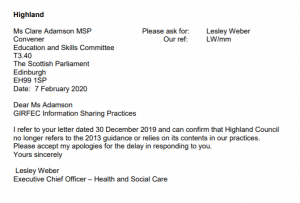
Council website (accessed 5 December 2020)
School policies and guidance – child wellbeing and safety (Child Protection policy)
There is a word document and a template for all schools to fill in.
Excerpts of interest:
“The well-being of children/young person in our care takes precedence over any other consideration.” [the law?]
“In order to achieve this we will:
- Follow the Highland Practice Model (GIRFEC) to work in partnership with parents, carers, Highland Council colleagues and other agencies to promote good practice in the area of child protection.”
REMEMBER:
Any concerns about the well-being of a child/young person need to be shared.
No matter how good we are at evaluating and assessing matters to do with children, when it comes to the child’s/young person’s welfare we cannot evaluate and assess potential danger, risk, damage, as we only know a tiny part of the whole picture. We must share our concerns with the designated/Named Person. [mixing teminology blurs the threshold]
Information sharing see:
http://www.forhighlandschildren.org/4-icspublication/index_81_180152905.pdf
http://www.gov.scot/Topics/People/Young-People/gettingitright/information-sharing
There is much more in this document that is of concern. It is a complete mish-mash of wellbeing and welfare; a recipe for disaster.
There is also the document referenced in the previous item Highland Children’s Services, Highland Practice Model Guidance (Getting it right for every child) (dated 2017) We found no updated version.
This version will be further reviewed and updated following publication of statutory guidance anticipated in summer/autumn 2017 to support implementation of the Children and Young People (Scotland) Act 2014
Section 5: Information Sharing
“Effective integrated practice which helps children develop to their potential requires timely, proportionate and appropriate information sharing. Practitioners should identify, act on, record and share concerns at an early stage.”
When consent has not been given, but there is a need to know, legislation assists the practitioner to decide whether sharing should take place. If information is to be shared to prevent harm, to prevent or detect serious crime, to improve the well-being of individuals or groups, or for public protection, and if the information to be shared is relevant and proportionate, then it should be shared.”
Our comment:
There is a flowchart on information sharing on page 39 that refers to the now superseded Data Protection Act 1998 and asks “Is the purpose of sharing to protect the welfare of a child?” – excellent, we say – but then says data may be shared citing Children and Young People Act (Scotland) 2014 which of course is all about ‘wellbeing’. Yet again, interchangeable use of ‘welfare’ and ‘wellbeing’ – it will only lead to trouble.
INVERCLYDE
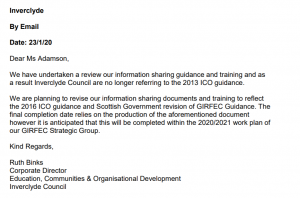
Council website (accessed 6 December 2020)
Main GIRFEC page links to a number of sections which reference the 2013 ICO ‘advice’ and are derived from Perth & Kinross Council’s outdated guidance..
“The Scottish Government intends to amend the information sharing provisions in the Child and Young People (Scotland) Act 2014 to provide greater clarity about the basis on which information will be shared to ensure compliance with the ECHR. These sections of the Act will not come into force until further notice. http://www.gov.scot/Resource/0050/00508709.pdf
See “Policy Update on Delivering the GIRFEC Approach” http://www.gov.scot/Resource/0050/00508709.pdf
Page last updated: 18 May 2017″ [Parts 4 & 5 are to be repealed]
There are further links to information sharing guides for Parents and Carers, Children and Young People and Practitioners
A Practitioner’s Guide to Information Sharing, Confidentiality and Consent to Support Children and Young People’s Wellbeing (dated Feb 2016, pre-judgment)
Adapted with consent from Perth & Kinross Council materials
Review date: continuous [we found no updated version] ECHR compliant: Yes [it’s not]
Excerpts of interest:
Child Protection – If we are to get it right for every child and young person’s wellbeing and intervene early enough (which will involve the appropriate and proportionate sharing of personal information and in some cases sensitive personal information, then there will be a reducing need for child protection interventions. To achieve this we need to change the emphasis from crisis management to early identification, intervention and support. However, it is important that we do not separate child protection, or any other intervention, from the Getting it Right for Every Child (GIRFEC) approach.
This remains the overarching approach for all matters relating to children and young people in Scotland. Child Protection is a Getting it Right for Every Child (GIRFEC) intervention where the emphasis on keeping Safe is the main Wellbeing Indicator. [blurring of thresholds pre-judgment]
This guidance is focussed on supporting and protecting the wellbeing of all children, young people and their families. As a practitioner, you may be working directly or indirectly within children, young people and their families. You may be working with them all of the time; some of the time; or only very occasionally. It is important that you understand the key role you have to play in supporting children and young people’s wellbeing.
There will be occasions where you will have to share information with other practitioners working between and across a wide range of other services and/or agencies. This could include services and/or agencies in the public, private third/voluntary sectors – including adult services. In this guidance, you will find information and advice, which will empower you to do so and support your practice.
Information Sharing
First and foremost, you should ask yourself the following five key GIRFEC questions:
- What is getting in the way of this child or young person’s well-being?
- Do I have all the information I need to help this child or young person?
- What can I do now to help this child or young person?
- What can my agency do to help this child or young person? and
- What additional help, if any, may be needed from others?
To answer all of these questions comprehensively, there will be a need for you to share information with other practitioners, working between and/or across a wide range of other services and/or agencies.
In practice, if you have any doubts whatsoever, or just a gut feeling that something is not quite right, then you should start by asking yourself the above five key GIRFEC questions. If in doubt, then act quickly. [their emphasis not ours]
In practice, if you are worried or concerned about a child or young person’s wellbeing, you should immediately alert your Line Manager/Supervisor and discuss your worry or concern with him/her. In his/her absence, you may find it helpful to share and discuss your worry or concern with a trusted colleague, as these can be difficult issues to deal with alone. [our emphasis]
A worry or concern can relate to a child or young person’s wellbeing, defined by the eight Wellbeing Indicators– safe; healthy; achieving; nurtured; active; respected; responsible; and included. A worry or concern can relate to a single issue, instance or incident or from a series of such events. It makes no difference. The principles are the same.
Remember, nothing whatsoever, in Scottish, UK and/or European Law and/or in the Scottish child protection legislative, policy and/or practice environments prevents you from sharing personal information and in some cases sensitive personal information where you are worried or concerned about a child or young person’s wellbeing. On the contrary, you are, within certain limitations and constraints, empowered to do so. This is information sharing in practice.
This approach has been further explained, supported and endorsed by Appendices 2 & 3:
(UK) Information Commissioner’s Office (ICO) Letter of Advice 2013 –Information Sharing; [we thought so!]
Scottish Government GIRFEC Programme Board Letter of Advice 2013 –Information Sharing; [ditto]
Scottish Government GIRFEC Bulletin Issue 1 2013 – Information Sharing.
If you are worried or concerned about a child or young person’s wellbeing, you should share your concerns quickly, efficiently and effectively. You may decide to make more enquiries first. If you do, do so quickly and ensure your focus remains on the safety of the child or young person. [blurred boundaries]
Remember – It is a common misconception that data protection legislation prevents you from sharing personal information and in some cases sensitive personal information where you are worried or concerned about a child or young person’s wellbeing. It does not. It actually empowers you. In these circumstances, you should share information.
Confidentiality
If you are worried or concerned about a child or young person’s wellbeing, there will be a need for you to share information. You need to be aware of the limitations and constraints of confidentiality and consent.
It is accepted that where there is a risk to a child or young person’s wellbeing, which may lead to harm, then it is acceptable to share confidential information in the best interest of the child or young person and/or in the public interest.
This duty of confidentiality is not absolute but should only be overridden if you, as the holder of the information, can justify the information being shared as being in the public interest (e.g. to protect wellbeing and/or others from harm). [pre-judgment misconception of Article 8(2)]
Any sharing of information should be relevant, necessary, legitimate, appropriate and proportionate and go no further than the minimum necessary to achieve the public interest objective of protecting a child or young person’s wellbeing.
And here we have it:
Recent advice from the (UK) Information Commissioner’s Office has clarified, what has been a misconception held by many re the Data Protection Act 1998 and lawful processing:
(UK) Information Commissioner’s Office (ICO) Letter of Advice 2013 –Information Sharing:
“Where a practitioner believes, in their professional opinion, that there is risk to a child or young person that may lead to harm, proportionate sharing of information is unlikely to constitute a breach of the Act in such circumstances. It is very important that the practitioner uses all available information before they decide whether or not to share. Experience, professional instinct and other available information will all help with the decision making process as will anonymised discussions with colleagues about the case. If there is any doubt about the wellbeing of the child and the decision is to share, the Data Protection Act should not be viewed as a barrier to proportionate sharing”.
In such cases, where information will be shared, consent should not be sought, as to do so would give the subject (child or young person and/or their parents/carers) a false belief that they can control the decision, which they cannot.
This should categorically not be on the council’s website more than four years after the July 2016 judgment and September 2016 revised ICO ‘advice’.
MIDLOTHIAN
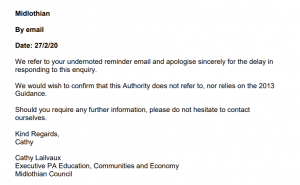
Our previous investigations revealed that the Named Person scheme was being rolled out in Midlothian and by June 2016 (a month before the Supreme Court judgment), training had been delivered to all staff who would have Named Person responsibilities. Midlothian claimed that 50% progress had been made, stating: “The Named Person legislation rollout has been delayed until 2017, work will continue for implementation and take account of changes to the legislation.”
Council website (accessed 6 December 2020)
The GIRFEC gateway page contains little information but lists numerous questions.
For answers
Find out about GIRFEC on the Scottish Government website
Here’s a summary of how we plan to Get it Right for Every Child (GIRFEC) in Midlothian (pdf)
Child Protection signposts to a separate joint East Lothian/Midlothian site which has a link to Inter-agency Child Protection Procedures for Edinburgh and the Lothian’s <sic> (dated 2015)
This clearly draws on the 2014 national child protection guidance, which in turn references the flawed 2013 ICO advice that sought to legitimise a lower threshold (wellbeing) for intervention than that permitted in law (as affirmed by the Supreme Court in 2016)
Inter-Agency Child Protection Procedures
“These procedures direct professionals in their responsibilities and action(s) in dealing with concerns about the safety and wellbeing of children.”
These procedures set out what agencies will do when children or young people may be at risk of abuse or neglect or have been harmed. The protection and wellbeing of the child must remain at the heart of all considerations and decisions.
Professionals must consider the child who is the subject of the referral, but must also consider the safety and wellbeing of any other child who may be at risk of harm.
Child protection investigations may identify gaps in services for children, parents or carers, even if it is established that there is no risk of significant harm. Where this is the case, the principles of Getting it right for every child should be followed to identify need and to secure appropriate services. Getting it right for every child principles promote action to improve the wellbeing of all children, and state that children and young people must be healthy, achieving, nurtured, active, respected, responsible, included and safe.
‘The safety, welfare and wellbeing of a child are of central importance when making decisions to lawfully share information with or about them’ National Guidance for Child Protection in Scotland (2014)
Information-sharing for child protection: general principles
The wellbeing of a child is of central importance when making decisions to share information with or about them lawfully;
Health staff have irect contact with children or involvement with parent(s), carer(s) or other family members in many situations that can give rise to concerns regarding the safety and wellbeing of children through abuse, lack of provision of effective care or where an individual’s circumstances impact negatively on children.
Where members of police staff have contact with children, their families/carers or other individuals that give rise to concerns regarding the safety or wellbeing of children – but where the need is not immediate or urgent, the circumstances must still be referred. [cue entry on to the illegal VPD]
Any member of staff who, through contact with children or other individuals, has concerns for the safety or wellbeing of a child or for the level of care being provided for a child, must act on these concerns.
Members of staff in education establishments are well placed to receive reports of abuse or to observe matters that may cause concerns over a child’s health and wellbeing.
In all cases where any form of abuse or neglect of a child is suspected, the need for medical assessment must be discussed during the inter-agency referral discussion. The examination must be comprehensive, gathering information about the child’s overall wellbeing, growth and development, not just documentation and interpretation of injuries. [child protection threshold/significant harm]
Agree the initial child protection plan to include the actions to be taken to ensure their wellbeing and safety.
The above document frequently refers to ‘safety and wellbeing’, conflating the two to blur the boundaries and misconstrue the intervention threshold.
Children’s Services privacy notice
“What lets us collect your information?
If we find out that children are not safe, we have a legal duty to take action. When we do this we are working under the:
Children and Young People (Scotland) Act 2014
Social Care (Self-directed Support) (Scotland) Act 2013
Social Work (Scotland) Act 1968
Children (Scotland) Act 1995We share information regularly with partner agencies and other organisation, the conditions for sharing your personal data are set out in an Information Sharing Agreement.” [we could not locate this]
MORAY
Council website (accessed 1 December 2020)
Information Sharing
Archive link

As for the links:
Information Sharing Practitioner Guidance – Approved Changes January 2018
Archive link includes reference to the ICO’s advice on the 1998 Data Protection Act (superseded by 2018 Data Protection Act to comply with the GDPR). Note the erroneous ‘perceived risk to wellbeing’ threshold:
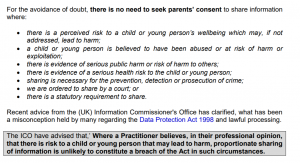
And this old chestnut from the ICO 2013 playlist:
Confidentiality does not prevent you from sharing a worry or concern about a child or young person’s wellbeing – it actually empowers you to do so.
Children and Young People (Information Sharing) (Scotland) Bill – June 2017
This bill was withdrawn in September 2019.
NORTH AYRSHIRE
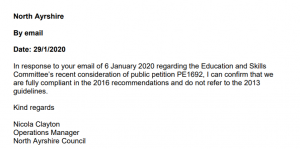
Council website (accessed 2 December 2020)
In Getting It Right in North Ayrshire we find the erroneous presumption that GIRFEC is enforceable! Parents and carers are told:
As a carer/parent of a child/young person you have a responsibility to ensure that they are safe, healthy, active, nurtured, achieving, respected, responsible and included.
Most of the information for practitioners is inaccessible to the pubic, but:
Getting it Right for every child is a Scottish Government Policy that sets out what agencies and practitioners need to do to come together and work with children, young people and their carers/families.*
A focus on improving [state] outcomes for children, young people and their families based on a shared understanding of wellbeing.
As a practitioner, parent, or a child or young person, ‘Getting it Right for every child’ provides everyone with a common language to describe wellbeing.** It provides values and principles that practitioners and agencies should work towards, common tools and guidance to help practitioners identify the best support for a child, as well as defining roles and processes to help everyone to identify and meet a child’s needs.
* No mention of consent
** Presumption of shared ideology that has no statutory forceBut there is some hope in ‘How we work‘:
10. Respecting confidentiality and sharing information
Seeking agreement to share information that is relevant and proportionate while safeguarding children and young people’s right to confidentiality.
NORTH LANARKSHIRE
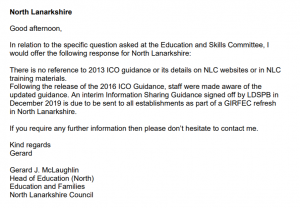
Council website (accessed 6 December 2020)
‘GIRFEC’ site search returns no useful links, but Google search returns a dedicated website:
GIRFEC in North Lanarkshire
GIRFEC starts with the universal services of health and education, focusing on early intervention, support and advice. [which can be declined]
Our vision for children and young people living in North Lanarkshire is that they will be safe, healthy, active, nurtured, achieving, respected, responsible, and included so they can realise their potential and grow to be successful learners, confident individuals, effective contributors and responsible citizens. [this is a state ideology, not a rights based approach]
In North Lanarkshire we have been embedding the GIRFEC approach for a number of years and practice continues to develop as we work to realise our vision to get it right for all of our children.[whose children?]
GIRFEC for Practitioners
We will be looking more closely at the links in this section.
In North Lanarkshire agencies have come together under GIRFEC and have agreed on a single pathway for planning and support. The pathway supports agencies to work together to assess, plan and assist children, young people and their families to develop their wellbeing. [this is the responsibility of parents and the state needs consent to gather and share ‘wellbeing’ data on children and their families as there is no other lawful basis below the child protection threshold, which is not wellbeing]
The pathway enables agencies across education, health and social work to use the Core Components of GIRFEC to ensure the most timely and proportionate support is available to children, young people and their families. The Children and Young People’s Pathway for Planning and Support encompasses the five levels of GIRFEC; Universal, Additional, Joint, Integrated and Compulsory Intervention which are reflected within a Model of Staged Intervention. [consent is required unless the established child protection threshold for compulsory intervention is met]
This links to Children and Young People’s Pathway for Planning and Support (PDF) (dated March 2018):
The Named Person’s role is to support, promote and safeguard the wellbeing of the child or young person. [only with consent as it has no statutory basis and Parts 4 & 5 of the 2014 Act are to be repealed] They monitor wellbeing [only with consent] in children and young people and can use single agency assessments to focus action and begin planning when it is needed, to improve wellbeing. (Wellbeing plan is used in health and Getting it right for me plan is used in education.) From time to time, children and young people may need some extra help available through the universal services. This will be sought using the Request for Assistance process. Any request for assistance should be accompanied by evidence of assessment and /or planning for the child or young person. [and, of course, evidence of informed consent]
The Named Person will usually inform the child, and where there is no risk to the child’s wellbeing, their parents that they intend to share relevant and proportionate wellbeing information about the child in order to support them carry out their role as Named Person. The views of the child and where appropriate the parents, will be sought and considered by the Named Person when they make any decision about what information they are likely to share and with whom. [advance notice must be given, and consent sought, unless the child protection threshold is met]]
The above document blatantly contradicts the Supreme Court judgment and should be withdrawn.
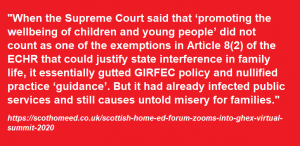
The United Nations Convention on the Rights of the Child (UNCRC) is fully embedded within the values and principles of the GIRFEC approach promoting the wellbeing of all children and young people.
UNCRC The Foundation of GIRFEC (PDF)
This was a vain attempt, in March 2013 (just as the ICO was publishing flawed ‘advice’) to replace the self-determined rights set out in the UNCRC with a state dictated and imposed GIRFEC outcomes framework. There is not a single reference to Article 16 of the UNCRC in the document, and the author seeks, wrongly, to extend Articles 3 and 5 to the extent of arbitrary interference with Article 8 of the ECHR. As the Supreme Court affirmed in 2016, and we have consistently highlighted
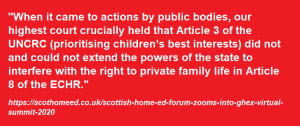
And Beware the well-behaving police
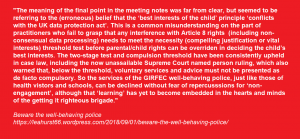
Sid and Shanarri
The truly toxic Sid and Shanarri, designed to indoctrinate nursery children into GIRFEC ideology, also have their own link in this section.
Sid and Shanarri is a storybook and game resource designed for use with pre-school children. It is available for use in all our nursery provisions to help young children understand what is meant by wellbeing. You can learn more at the website SidandShanarri.co.uk
The dodgy duo were previously pilloried in the Scottish Review in Fall of a Named Person (November 2017) and Z-Listers (September 2018)
The Girfec National Practice model provides a framework for practitioners in all services to gather, structure and analyse information in a consistent way. The framework helps staff to identify and understand the strengths and pressures for children and their parents, the child or young person’s needs and any risks. The model promotes the participation of children, young people and families as central to assessment and planning.
No mention of the voluntary consent based approach to GIRFEC and string implication that it is a statutory requirement for families to agree with a state-dictated notion of wellbeing (which has no precise definition).
Information Sharing Interim Guidance (December 2019)
3. Sharing Information
Sharing information is an essential part of your job when working with children and young people. How much information you share, with whom and when, can have a significant impact on individuals’ lives. Information sharing aims to ensure that children and young people receive the right services at the right time to prevent a need from becoming more acute and difficult to meet. [preventive approach requires consent below the chid protection threshold]
Uncertainty about sharing information cannot be allowed to stand in the way of the need to keep children safe and to promote, support and safeguard their wellbeing.[this contradicts the Supreme Court judgment which reaffirmed the threshold for intervention, which is not ‘wellbeing’] You must take responsibility for deciding what information should be shared, you cannot assume that someone else will pass it on. This is particularly important when there are concerns that a child or young person is, or is likely to be, at risk of [significant] harm. On many occasions, [where the threshold has been met] this will require you to seek and exchange personal information about children, young people and others.
Our comment:
Much of the information in this interim guidance is directly challengeable. Since GIRFEC has no statutory basis (Parts 4 & 5 of the CYP Act 2014 are to be repealed), ‘wellbeing’ has no precise legal definition and the Supreme Court held that ‘promoting, supporting and safeguarding wellbeing’ was a parental responsibility and not one of the exemptions in Article 8(2) of the ECHR, the public task basis cannot be relied upon by practitioners to process personal and/or special category data unless the child protection threshold is met. Consent is the correct basis.
ORKNEY ISLANDS
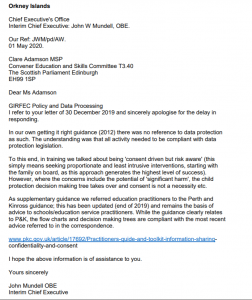
Council website (accessed 6 December 2020)
Getting it Right for Every Child
This guide provides an overview of the Getting it Right for Orkney’s Children and Young People approach and developments so far. It provides information on emerging national and local thinking, building from the work of national pathfinders and existing local good practice. It shows how the practice model and tools can be used to secure better outcomes for children and young people.
Links to
Guidance for professionals in Orkney (dated 2012, clearly not much ’emerging thinking’ before or after the 2013 ICO ‘advice’ or 2016 judgment)
This ‘Getting it Right for Every Child Guidance’ is compatible with the principles of the European Convention of Human Rights and the Human Rights Act 1998 The Guidance also complies with the UN Convention on the Rights of the Child 1989. The Guidance is also compatible with the equality and diversity principles and duties set out within the Equality Act 2010, and meets the requirements of national legislation and local policy on inclusive practice. [No mention of the then Data Protection Act 1998. This guidance preceded the 2013 ICO ‘advice’ that encouraged a data sharing free-for-all]
Practitioners in Orkney are developing the skills and applications of joint assessment, and also integrated assessment, where information from many sources is shared and discussed. Practitioners have described the value of sharing information in this way at meetings, rather than writing separate reports. This results in a deeper understanding of the situation for a child or young person as the impact of any issues is seen in the context of his or her wider life.
‘Request for Involvement’ and ‘Referral’
We have developed a form for formally asking other professionals to join the team around a child or young person. This is known as a ‘request for involvement’. It signals that another practitioner is being asked to become involved, without necessarily taking over. The existing Named Person or Lead Professional maintains their original role. The form includes consent to share information with other professionals working with the individual.
Getting it Right for Orkney’s Children and Young People
Getting it Right for Every Child is a national initiative. The impetus driving it is the ongoing need to recognise and develop good practice that protects and supports children and young people by altering practitioners to their wider needs and how these can be met. Where each practitioner is vigilant and communicating with colleagues across disciplines, it is less likely that unmet needs will endure and be compounded. [consent not mentioned]
‘Getting it Right for Orkney’s Children and Young People’ describes the approach taken locally which aims to give all children and young people the best start and sustained support throughout their childhood. The overarching concept is a common approach across all agencies, that supports the delivery of appropriate, proportionate and timely help to all children and young people as they need it. This is expressed as:
“..the right help, at the right time, in the right way” [which requires consent and can be declined without adverse consequences]
The Related Downloads section of the page includes ‘Getting it Right for Orkney’s Children and Young People – Guidance for Professionals in Orkney’ and ‘Request for Involvement’ form. [this links to the 2012 Guidance outlined above]
PERTH & KINROSS
Response to the Convener of the Education & Skills Committee
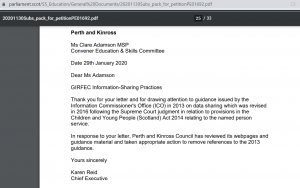
Council website
As of 1 December 2020, this information remains front and centre on the council’s website. While they many not reference it directly, it includes a verbatim excerpt from the 2013 ICO ‘advice’ with the wrong threshold. The page also links to the 2014 national child protection guidance, which still also cites the wrong threshold of ‘wellbeing’.

The Practitioners’ Toolkit with links to Information Sharing guidance sit below this statement.
Perth and Kinross Code of Practice: Information Sharing, Confidentiality and Consent
There is not one mention of wellbeing in guidance, refreshed on 30 September 2020, but the document looks almost identical to a previous version with the word welfare substituted for wellbeing.
Excerpts of interest:
1.3 The Partnership recognises that the appropriate processing of information (data), which includes sharing information, is vital in order to safeguard, support and promote the welfare of children and young people.
1.7 This Code of Practice is advisory and does not attempt to replicate, or explain the extensive legislative and policy framework; but affirms and continues to support the Perth and Kinross Practitioner’s Guide and Toolkit: Information Sharing, Confidentiality and Consent.
2.3 Proportionate information sharing can assist with the successful implementation of Getting it Right in Perth and Kinross, by ensuring that children and young people get the right help; at the right time; from the right people; when they need it and for as long as they need it. The welfare of all children and young people is paramount.
2.22 Practitioners must always exercise professional judgement and common sense when sharing information. They must understand what bases they are relying upon when sharing information and must only share the necessary information proportionately.
2.25 For the purposes of safeguarding, supporting and promoting the welfare of children and young people, practitioners can therefore act to limit that Article 8 ECHR right on the basis of either protecting the health or morals of an individual or protecting the rights and freedoms of others. To test whether actions comply with the ECHR, practitioners should ask themselves the following questions:
- Am I interfering with an Article 8 right?
- Is the action I propose to take lawful?
- Does the action pursue one of the legitimate aims?
- Is the action that I propose to take necessary to achieve that aim?
- Is the action proportionate? That is – am I doing only as much as I need to in order to achieve the aim?
3.3 Confidentiality does not apply where the matter is clearly one of protecting children and young people. The welfare of children and young people is paramount.
3.4 Confidentiality is not an absolute right. Practitioners have a duty of care and it has long been established that just cause, or excuse and / or acting in the public interest are defences to any action for breach of confidence.
3.6 Sharing information should only occur where practitioners can justify doing so in terms of the data protection principles and where they can identify with a lawful basis specified in Article 6 and / or Article 9 of the GDPR.
RENFREWSHIRE
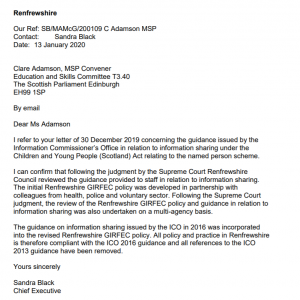
Council website (accessed 6 December 2020)
Our previous investigations revealed that full statutory duties in Parts 4 & 5 of the 2014 Act were to be in place by the end of August 2016. A September 2016 report noted:
“A local, interagency implementation plan was at a final stage to ensure the relevant policy, procedure, communications and training were in place for the planned commencement of the Act. This work has been suspended pending the outcome of the Scottish Government response to the Supreme Court.”
The main GIRFEC gateway page includes a plethora of links
What is GIRFEC?
Renfrewshire’s Getting it Right for Every Child (GIRFEC) policy has been developed to provide a rationale and structure within which services for children and young people are planned, delivered and reviewed by all agencies under the direction of the Renfrewshire Children and Young People Thematic Board, Renfrewshire Children’s Services Partnership (RCSP) and Renfrewshire Child Protection Committee (RCPC).
The GIRFEC policy should be used by all agencies involved in providing a service to any child or young person and their families and carers in Renfrewshire.
Services to adults should be familiar with and follow the principles of the GIRFEC policy and approach in their work with adults who may have children or caring responsibilities.
Excerpts of interest from The GIRFEC approach:
Children’s well-being is important at every stage of childhood. Every child needs to be healthy, achieving, nurtured, active, respected and responsible, and, above all, safe.[wellbeing is self defined and not a matter for state diktat] These are the eight indicators of well-being (SHANARRI) which are set within the ‘four capacities’ which are at the heart of the Curriculum for excellence. [outcomes driven, not rights based]
Renfrewshire’s GIRFEC policy is in place to make sure that children, young people and their families receive the help they need when they need it. [implies this is whether they want it or not, contrary to the Supreme Court ruling that rendered it voluntary with no adverse consequences for declining advice] As children and young people progress on their journey through life, some may have temporary difficulties, some may live with challenges and some may experience more complex issues. Sometimes they – and their families – are going to need help and support. [with their agreement]
The Getting it Right for Every Child (GIRFEC) approach ensures that when we provide support, it is based on the level of need for each child. [as agreed by the chid/parents]
From Renfrewshire and GIRFEC:
Practitioners need to work together to support families, and where appropriate, take early action at the first signs of any difficulty – rather than only getting involved when a situation has already reached crisis point. This means working across organisational boundaries; putting children and their families at the heart of decision making and giving all our children and young people [whose children] the best possible start in life.
In Renfrewshire, we will:
Promote the well-being of individual children and young people based on: understanding how children and young people develop in their families and communities and addressing their needs at the earliest possible time.
Keep children and young people safe: emotional and physical safety is fundamental and is wider than child protection. [the threshold shoudl be made clear]
Put the child at the centre: children and young people should have their views listened to and they should be involved in decisions which affect them.
Take a whole child approach: recognising that what is going on in one part of a child or young person’s life can affect many other areas of his or her life [consent needed for data processing]
Provide additional help which is appropriate, proportionate and timely: providing help as early as possible considering short and long-term needs [advice may be declined]
Work in partnership with families: supporting wherever possible those who know the child or young person well, know what they need, what works well for them and what may not be helpful [only with consent]
Support informed choice: supporting children, young people and families in understanding what help is possible and what their choices are [especially consent]
Respect confidentiality in sharing information: seeking agreement to share information that is relevant and proportionate while safeguarding children and young people’s right to confidentiality [that’s better, and consent / advice may be declined]
Promote the same values across all working relationships: recognising respect, patience, honesty, reliability, resilience and integrity are qualities valued by children, young people, their families and colleagues
Make the most of bringing together each worker’s expertise: respecting the contribution of others and co-operating with them, recognising that sharing responsibility does not mean acting beyond a worker’s competence or responsibilities
Co-ordinate help: recognising that children, young people and their families need practitioners to work together, when appropriate, to promote the best possible help [appropriate means with consent]
Build a competent workforce to promote children and young people’s wellbeing: committed to contributing individual learning and development and improvement of inter-professional practice. [with consent of the service receivers]
See also:
What GIRFEC means
Core components of GIRFEC
Values and principles of GIRFEC
GIRFEC National Practice Model
SCOTTISH BORDERS
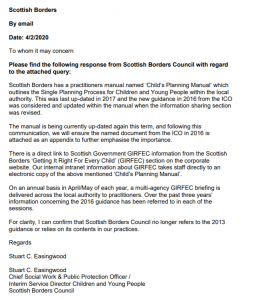
Council website (accessed 6 December 2020)
GIRFEC page has minimal information with a link to the Scottish Government site.
Getting it right for every child
Getting it right for every child (GIRFEC) is the national approach in Scotland to improving the outcomes and supporting the wellbeing of our children and young people by offering the right help at the right time from the right people. It supports them and their parent(s) to work in partnership with the services that can help them. [no mention of the voluntary nature of GIRFEC]
Partnership working
To join up children’s services across the Scottish Borders we are working locally with:
- NHS Borders
- Police Scotland
- The voluntary sector
No mention of consent or the lawful basis / threshold for information sharing between services. A cop-out that does not reassure families.
SHETLAND ISLANDS
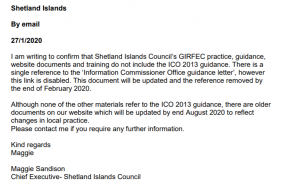
Council website (accessed 6 December 2020)
We found conflicting information, with outdated links to these ‘older documents’ that are still publicly available and should have been removed. By contrast, there is some excellent and accurate information also on the site that makes clear the voluntary nature of GIRFEC and the importance of informed consent.
GIRFEC Resources page includes:
GIRFEC Shetland guidance (dated August 2014, still available on the site)
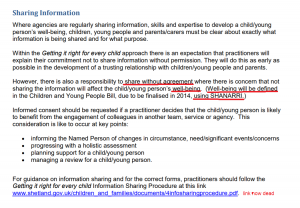
Contacting and Sharing Information with a Named Person (dated July 2017)
No mention of consent and mis-terming of home education as ‘home schooling’.
If you are still not sure about how to share information with the Named Person, please contact Planning and Information on: 01595 744000.
However, we also found an undated page, in the section for young people, with much more accurate information
Information Sharing and GIRFEC
We need consent before GIRFEC is used and information about your child is shared. The staff asking permission will explain more about what this means. [Bravo!]
Who gives consent?
- for children over 12 years of age, consent will usually be sought from them.
- for children under 12 years of age, if they understand the nature and consequences, consent will be sought from them. If not, consent will be sought from a parent or carer.
- when a child is over 12, but does not have the capacity to make the decision, consent will be sought from the person with legal authority to act on the child’s behalf.
You can say no!
If you do not wish GIRFEC to be used and information about your child to be shared in the way described in this leaflet, you can say no. Please make this clear to the person who is asking you for consent.
If you say no, but we feel that a child’s immediate safety is at risk, we can share their information without consent.
SOUTH AYRSHIRE
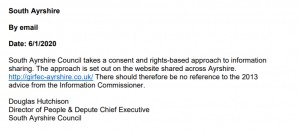
Council website (accessed 2 December 2020)
And this (updated 20 April 2020):
Team around the Child Model in South Ayrshire
Excerpts of interest:
The appropriate information is recorded in SEEMiS and shared using AYRshare.
At the meeting a Lead Professional is allocated and they manage the construction and co-ordination of the Child’s Plan and arrange reviews by the TAC as appropriate. There is no need for a minute of the TAC, the Child’s action plan is the output with a note of any disagreement or part of a discussion taken if required.
Using IT has also improved information sharing. The use of pastoral notes has been rolled out throughout our primary schools and the implementation of the SEEMiS Wellbeing Application will further reduce the time taken to complete a wellbeing assessment and improve information sharing within Education. AYRshare has been rolled out to specialist teams in Education and Health and is used to share Child Plans and integrated chronologies with all partners apart from the private and voluntary sectors. They are currently being considered for the next phase of AYRshare rollout.*
* No mention of informed consent for ‘wellbeing’ assessments via a SEEMiS application from which we can infer automated data processing
And there is no evidence of a rights-based approach.
SOUTH LANARKSHIRE
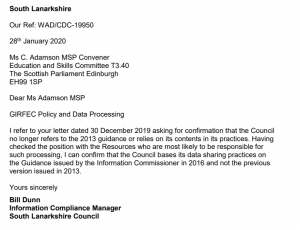
Council website (accessed 6 December 2020)
Its aim is for all workers in nurseries, schools and leisure centres, health centres and hospitals, family centres, social work centres, housing offices and in the community to work together and change culture and practice so that all children and young people can reach their full potential.
South Lanarkshire Council, North Lanarkshire Council and NHS Lanarkshire are all GIRFEC partners in Lanarkshire. [no mention of information sharing protocol or consent of data subjects]
It links to the Scottish Government site and to:
GIRFEC Leaflet for Parents and Carers (undated)
Informed Consent: Information will not be passed on about you and your child to another agency without your informed consent. (The exception to this would be relating to a child protection matter).
More information can be sought from
www.girfecinlanarkshire.co.uk/ [dead link]
www.scotland.gov.uk/gettingitright
Previously noted:
Following the Supreme Court judgment in 2016, a South Lanarkshire Council spokesman said that every child in a South Lanarkshire school has had a Named Person since about 2009, with GIRFEC running from 2006.
From archived Newsletter for services in South Lanarkshire 5th Edition – June 2014
Notification of Child Protection Concern
Agreement has been reached that the Lanarkshire ‘Notification of Concern’ paperwork will now be renamed the ‘Notification of Child Protection Concern’ paperwork. The two Child Protection Committees of North and South Lanarkshire were in agreement to the name change when some concerns were raised that agencies were using the Notification of Concern paperwork to raise general wellbeing concerns between agencies rather than child protection concerns. Consequently, the title has been changed to assist staff from all agencies ensure that clarity is maintained when dealing with child protection issues.
STIRLING
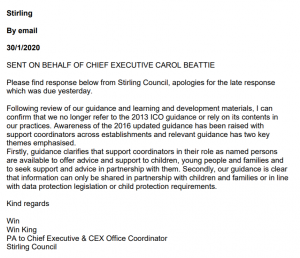
Council website (accessed 5 December 2020)
Our previous investigations had revealed that the Care Inspectorate reported in 2014 that “Staff in education are confident in their role as named person” in the Stirling Council area. The Council website stated (when archived in October 2017) that implementation of Part 4 (Named Persons) was paused so that the Scottish Government could make necessary changes to information sharing provisions in the Act. Information sharing in Stirling would continue in line with the Data Protection and Human Rights Acts.
The GIRFEC pages were all updated in October/November 2019 with minimal information and now link to the Scottish Government’s website.
WEST DUNBARTONSHIRE
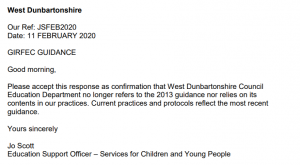
Council website (accessed 5 December 2020)
West Dunbartonshire Council said in August 2016 provisions of the Named Persons scheme were already in force through the Getting It Right For Every Child (GIRFEC) scheme. Council SNP spokesman Jonathan McColl said there was “no reason” for the council to stop preparing to enact the legislation.
We found an outdated leaflet, The vital importance of getting it right for every child and young person (dated 2011, predating the ICO ‘advice’)
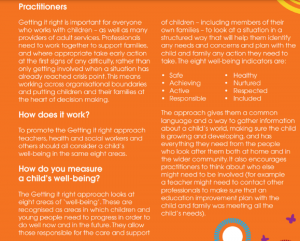
Evidence from home educating parents indicates ongoing misuse of personal and special category data and unwarranted interference in parental decisions on the best interests / wellbeing of their children. Such are the concerns that the Scottish Home Education Forum anticipates making a Section 70 complaint to Ministers.
WEST LOTHIAN
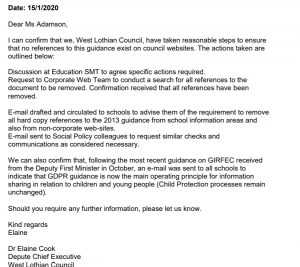
Council website (accessed 5 December 2020)
From previous investigation, we are aware that Named Persons were introduced in West Lothian as early as Autumn 2013 (links now dead). In 2016/17, there were GIRFEC training sessions for voluntary and childcare organisations.
This practical workshop will give you all the information that you need to know about ‘Getting it Right for Every Child’. It will discuss and look at examples of how you can meet the SHANARRI well-being indicators in practice and explore exciting ways to document these in your setting with the children that you work with.
A few old links to power point presentations found that are obviously no longer in use, having predated the 2014 Act (but evidence the premature and presumptive training staff to implement unlawful GIRFEC information gathering and sharing).
The council does seem to have taken steps to remove references to previous ICO advice and to notify public facing services, but we are aware of practice that still falls short.
Child Protection (for Professionals section)
Links (as expected) to the 2014 Child Protection guidance . However, the Information sharing 2019 [115.98KB] (January 2019) letter from West Lothian Health & Social Care Partnership appears to reflect the updated ICO guidance.

